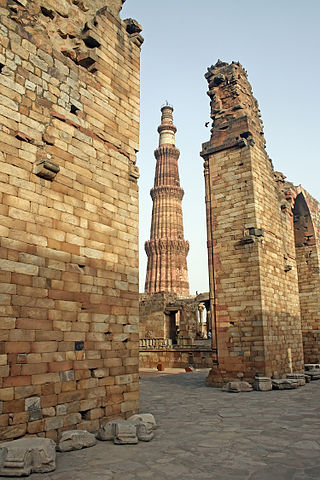
The Qutb Minar complex are monuments and buildings from the Delhi Sultanate at Mehrauli in Delhi, India. Construction of the Qutub Minar "victory tower" in the complex, named after the religious figure Sufi Saint Khwaja Qutbuddin Bakhtiar Kaki, was begun by Qutb-ud-din Aibak, who later became the first Sultan of Delhi of the Mamluk dynasty. It was continued by his successor Iltutmish, and finally completed much later by Firoz Shah Tughlaq, a Sultan of Delhi from the Tughlaq dynasty (1320–1412) in 1368 AD. The Qubbat-ul-Islam Mosque, later corrupted into Quwwat-ul Islam, stands next to the Qutb Minar.

Masjid-i-Jehan-Numa, commonly known as the Jama Masjid of Delhi, is one of the largest mosques in India.

The Jama Masjid is a mosque in the Kalbadevi neighborhood, near Crawford Market in the South Mumbai region of Mumbai, India.

Jama Masjid is a mosque in Srinagar, Jammu and Kashmir, India. Situated at Nowhatta in the Old City, the Mosque was commissioned by Sultan Sikandar in 1394 CE and completed in 1402 CE, at the behest of Mir Mohammad Hamadani, son of Mir Sayyid Ali Hamadani, and is regarded as one of the most important mosques in Kashmir. The mosque is located downtown, a central zone in the religio-political life in Srinagar. Thronged by Muslims every Friday, it is a prime tourist attractions of Srinagar.
Kukshi is a town in Dhar district of Madhya Pradesh state, India. Kukshi has population of around 37,482 making it a Tier-3 city and a Semi-Urban centre. It is a Nagar Parishad. Kukshi is famous for the business of cotton, mirchi, gold and silver, and ready made garments.
Saidpur is a town and a nagar panchayat in the Badaun district of the Indian state of Uttar Pradesh.

The Taj-ul-Masajid or Tāj-ul-Masjid, is a mosque situated in Bhopal, Madhya Pradesh, India. It is the largest mosque in India and one of the largest mosques in the world.

Eidgah or Idgah, also Eid Gah or Id Gah is a term used in South Asian Islamic culture for the open-air enclosure usually outside the city reserved for Eid prayers offered in the morning of Eid al-Fitr and Eid al-Adha. It is usually a public place that is not used for prayers at other times of the year. On the day of Eid, the first thing Muslims do in the morning is gather usually at a large open ground and offer special prayers, in accordance with the Sunnah. Although the usage of the term Eidgah is of Indian origin, it may be used for the musalla, the open space outside a mosque, or other open grounds where Eid prayers are performed, due to the lack of a specific Islamic term for a site of Eid observance. The Eidgah is mentioned in the famous Bengali poem by Kazi Nazrul Islam, O Mon Romzaner Oi Rozar Sheshe.
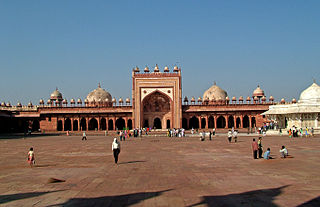
The Jama Masjid is a 16th-century congregational mosque in the UNESCO World Heritage Site of Fatehpur Sikri in Uttar Pradesh, India. Constructed by Mughal Emperor Akbar, it is one of the largest mosques in India. It is the most sought after pilgrimage site by the devotees. It is also one of the most visited tourist destinations in Agra district. Some of the designs of the mosque reflect beautiful Iranian architecture.
Hallaur or Hallor village is located in Domariyaganj Tehsil of Siddharthnagar district in Uttar Pradesh, India. Domariyaganj is the nearest town to Hallaur village.
Islam is an Abrahamic monotheistic religion teaching that there is only one God (Allah) and that Muhammad is His last Messenger.
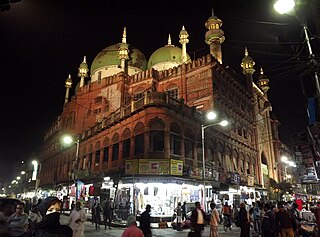
The Nakhoda Musjid is the principal mosque of Kolkata, India, in the Chitpur area of the Burrabazar business district in Central Kolkata, at the intersection of Zakaria Street and Rabindra Sarani.
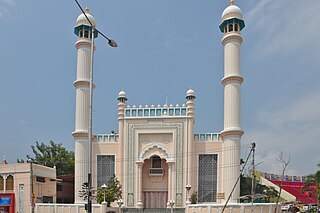
Masjid-i Jahān-Numā, commonly known as the Palayam Juma Masjid of Trivandrum, is the principal mosque of Trivandrum in Kerala, India. It is a Jama Masjid.
Kali : کالی دولت خان is a village in the Yavatmal district of Maharashtra, India. It is named after Daulat Khan Patel. Kali (DK) is 20 km away from Pusad, which is to the east of Mahagaon. The population of Kali (DK) is around 25,000.
Shah Deccan Qutub Kokan Khwaja Pir Hafiz Habib Ali Shah was born in a Sufi family, whose lineage is traced back to Abu Bakr, the first Caliph of Islam, his ancestors were Sufi masters. From Syedna Abu Bakr Siddiq, the forefathers of Pir Khaja Habib Ali Shah حضرت حبئب علی شاہ obtained the spiritual education (Tassawuf/Tariqat) and bestowed with Caliphat from their fathers
Walidpur is a village in Mau district in the Indian state of Uttar Pradesh.
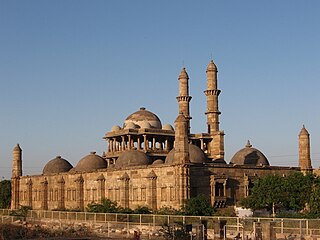
Jami Masjid in Champaner, Gujarat state, western India, is part of the Champaner-Pavagadh Archaeological Park, a UNESCO World Heritage Site, and is among the 114 monuments there which are listed by the Baroda Heritage Trust. It is located about 150 feet (46 m) east of the city walls (Jahdnpandh), near the east gate.

Persian Inscriptions on Indian Monuments is a book written in Persian by Dr Ali Asghar Hekmat E Shirazi and published in 1956 and 1958 and 2013. New edition contains the Persian texts of more than 200 epigraphical inscriptions found on historical monuments in India, many of which are currently listed as national heritage sites or registered as UNESCO world heritage, published in Persian; an English edition is also being printed.
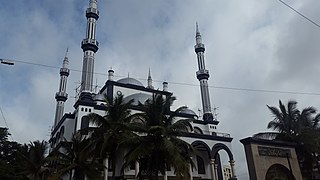
Masjid-e-Bilal is one of the largest mosques of Bangalore, Karnataka, India. It was inaugurated in mid-2015. The Turkish-style 'Masjid Eidgah Bilal' on Bannerghatta road was consecrated on 11 June. The mosque sits on the corner of a traffic intersection on a popular thoroughfare of southern part of the city. Prestige Group developers undertook the construction which began in 2010 and was completed recently. At that time Janab Alhaj Habeeb Khan Saheb was president of this committee from 2004 to 2015. The mosque constructed at a cost of Rs. 200,000,000 provides space for 6,500 people to pray at a time. A considerable portion of the cost was contributed by the Prestige Group.
Lucknow is known as a city of imambaras as it contains a large number of them, among which, some are very well known.













